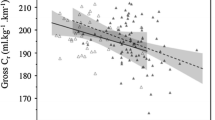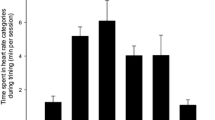Summary
The influence of an increase in training volume (ITV; February 1989) vs intensity (ITI; February 1990) on performance, catecholamines, energy metabolism and serum lipids was examined in two studies on eight, and nine experienced middle- or long-distance runners; seven participated in both studies. During ITV, mean training volume was doubled from 85.9 km · week−1 (pretrial phase) to 174.6 km within 3 weeks. Some 96%–98% of the training was performed at 67 (SD 8)% of maximal performance. During ITI, speed-endurance, high-speed and interval runs increased within 3 weeks from 9 km · week−1 (pretrial phase) to 22.7 km · week−1 and the total training distance from 61.6 to 84.7 km · week−1. The ITV resulted in stagnation of running velocity at 4 mmol lactate concentration and a decrease in total running distance in the increment test. Heart rate, energy metabolic parameters, nocturnal urinary catecholamine excretion, low density, very low density lipoprotein-cholesterol and triglyceride concentrations decreased significantly; the exercise-related catecholamine plasma concentrations increased at an identical exercise intensity. The ITI produced an improvement in running velocity at 4 mmol lactate concentration and in total running distance in the increment test; heart rate, energy metabolic parameters, nocturnal catecholamine excretion, and serum lipids remained nearly constant, and the exercise-related plasma catecholamine concentrations decreased at an identical exercise intensity. The ITV-related changes in metabolism and catecholamines may have indicated an exhaustion syndrome in the majority of the athletes examined but this hypothesis has to be proven by future experimental studies.
Similar content being viewed by others
References
Barron GL, Noakes TD, Levy W, Smith C, Millar RP (1985) Hypothalamic dysfunction in overtrained athletes. J Clin Endocrinol Metab 60: 803–806
Berg A, Jakob E, Lehmann M, Dickhuth HH, Huber G, Keul J (1990) Aktuelle Aspekte der modernen Ergometrie. Pneumologie 44: 2–13
Booth F (1977) Effect of endurance exercise on cytochrome c turnover in skeletal muscle. Ann NY Acad Sci 301: 431–439
Braumann KM, Maassen N, Busse M (1988) Die Problematik der Interpretation trainings-begleitender Laktatmessungen. Dtsch Z Sportmed 39:365–368
Brodde ED, Daul A, O'Hara N (1984) β-adrenoreceptor changes in human lymphocytes, induced by dynamic exercise. Naunyn Schmiedebergs Arch Pharmacol 325:190–192
Da Prada M, Zürcher G (1976) Simultaneous radioenzymatic determination of plasma and tissue adrenaline, noradrenaline and dopamine within the fentomole range. Life Sci 19:1161–1174
Dickhuth HH, Wohlfahrt B, Hildebrand D, Rokitzki L, Huonker M, Keul J (1988) Jahreszyklische Schwankungen der Ausdauerleistungsfähigkeit von hochtrainierten Mittelstreckenläufern. Dtsch Z Sportmed 39:346–353
Ekblom B, Kilbom A, Soltysiak J (1973) Training, bradycardia and autonomic nervous system. Scand J Clin Lab Invest 32:252–256
Galbo H, Christensen NJ, Mikines KJ, Sonne B, Hilsted J, Hagen C, Fahrenbug J (1981) The effect of fasting on the hormonal response to graded exercise. J Clin Endocrinol Metab 52:1106–1112
Gendrisch G (1989) Vergleichende Untersuchungen zur individuellen anaeroben Schwelle von hochtrainierten Mittel- und Langstreckenläufern im Feld- und Labortest. Inaugural-Dissertation. Medical Faculty of the University of Freiburg, Freiburg, FRG
Guezennec Y, Leger L, Lhoste F, Aymond M, Pesquies PC (1986) Hormone and metabolic response to weight lifting training sessions. Int J Sports Med 7: 100–105
Hagberg JM, Hickson RC, McLane JA, Ehsani AA, Winder WW (1979) Disappearance of norepinephrine from the circulation following strenuous exercise. J Appl Physiol 47:1311–1314
Hartley LH, Mason JW, Hogan RP, Jones LG, Kotchen TA, Mougey EH, Wherry FE, Pennington LL, Ricketts PT (1972) Multiple hormonal response to graded exercise in relation to physical training. J Appl Physiol 33:602–606
Hohorst HJ (1962) L-(+)-Laktat. Bestimmung mit Laktatdehydrogenase und DPN. In: Bergmeyer HU (ed) Methoden der enzymatischen Analyse. Verlag Chemie, Weinheim, pp 266–277
Hollmann W, Hettinger T (1980) Sportmedizin, Arbeits- und Trainingsgrundlagen. Schattauer Verlag Stuttgart, pp 549–552
Israel S (1976) Zur Problematik des Übertrainings aus internistischer und leistungsphysiologischer Sicht. Med Sport 16:1–12
Keul J, Lehmann M, Dickhuth HH, Berg A (1980) Vergleiche von Herzvolumen, nomographisch ermittelter Sauerstoffaufnahme und Wettkampfleistung bei Ausdauersportarten. Dtsch Z Sportmed 31:148–154
Kindermann W (1986) Das Übertraining — Ausdruck einer vegetativen Fehlsteuerung. Dtsch Z Sportmed 37:138–145
Kniffki KD, Mense S, Schmidt RF (1981) Muscle receptors with fine afferent fibers which may evoke circulatory reflexes. Circ Res 48 [Suppl I]:25–31
Kuipers H, Keizer HA (1988) Overtraining in elite athletes. Sports Med 6:79–92
Lehmann M (1989) Trainierbarkeit des Herz-Kreislauf-Systems bei Gesunden und Herzkranken. In: Hopf R, Kaltenbach M (eds) Bewegungstherapie für Herzkranke. PMI Verlag, Frankfurt, pp 27–38
Lehmann M, Keul J (1985) Capillary-venous differences of free plasma catecholamines at rest and during graded exercise. Eur J Appl Physiol 54:502–505
Lehmann M, Keul J (1986) Free plasma catecholamines, heart rates, lactate levels, and oxygen uptake in competition weight lifters, cyclists and untrained control subjects. Int J Sports Med 7:18–21
Lehmann M, Dickhuth HH, Schmid P, Porzig H, Keul J (1984) Plasma catecholamines, β-adrenergic receptors, and isoproterenol sensitivity in endurance trained and non-endurance trained volunteers. Eur J Appl Physiol 52:362–369
Mader A, Liesen H, Heck H, Philippi H, Rost R, Schürch P, Hollmann W (1976) Beurteilung der sportartspezifischen Ausdauerleistungsfähigkeit im Labor. Sportarzt Sportmed 27:80–88 und 109–112
Péronnet F, Cléroux J, Perrault H, Cousineau D, Champlain J, Nadeau R (1981) Plasma norepinephrine response to exercise before and after training in humans. J Appl Physiol 51: 812–815
Sachs L (1978) Angewandte Statistik. Springer, Berlin Heidelberg New York, pp 230–235
Slein MW (1962) D-Glucose. Bestimmung mit Hexokinase und Glucose-6-Phosphat-Dehydrogenase. In: Bergmeyer HU (ed) Methoden der enzymatischen Analyse. Verlag Chemie, Weinheim, pp 117–123
Tohmeh JF, Cryer PE (1980) Biphasic adrenergic modulation of β-adrenergic receptors in man. J Clin Invest 65:836–840
Trap-Jansen J, Christensen NJ, Clausen JP, Rasmussen B, Klausen K (1973) Arterial noradrenaline and circulatory adjustment to strenuous exercise with trained and non-trained muscle groups. In: Selinger V (ed) Physical Fitness. Charles University Press, Prague, pp 414–418
Wallin BG (1981) Relationship between sympathetic outflow to muscles, heart rate and plasma norepinephrine in man. In: Delius W, Gerlach E, Grobecker H, Kübler W (eds) Catecholamines and the heart. Springer, Berlin Heidelberg New York, pp 11–17
Weicker H (1988) Purinnukleotidzyklus und muskuläre Ammoniakproduktion. Dtsch Z Sportmed 39:172–178
Wieland H, Seidel D (1978) Fortschritte in der Analytik des Lipoproteinmusters. Inn Med 5:290–300
Wilmore JH, Davis JA, O'Brien RS, Vodak PA, Walder TR, Amsterdam EA (1980) Physiological alterations consequent to 20-week conditioning programs of bicycling, tennis and jogging. Med Sci Sports Exerc 12:1–8
Winder WW, Hickson RC, Hagberg JM, Ehsani AA, McLane JA (1979) Training induced changes in hormonal and metabolic responses to submaximal exercise. J Appl Physiol 46:766–771
Yamaguchi N, de Champlain J, Nadeau R (1975) Correlation between the response of the heart to sympathetic stimulation and the release of endogenous catecholamines into the coronary sinus of the dog. Circ Res 36:662–668
Author information
Authors and Affiliations
Rights and permissions
About this article
Cite this article
Lehmann, M., Baumgartl, P., Wiesenack, C. et al. Training-overtraining: influence of a defined increase in training volume vs training intensity on performance, catecholamines and some metabolic parameters in experienced middle- and long-distance runners. Europ. J. Appl. Physiol. 64, 169–177 (1992). https://doi.org/10.1007/BF00717956
Accepted:
Issue Date:
DOI: https://doi.org/10.1007/BF00717956




